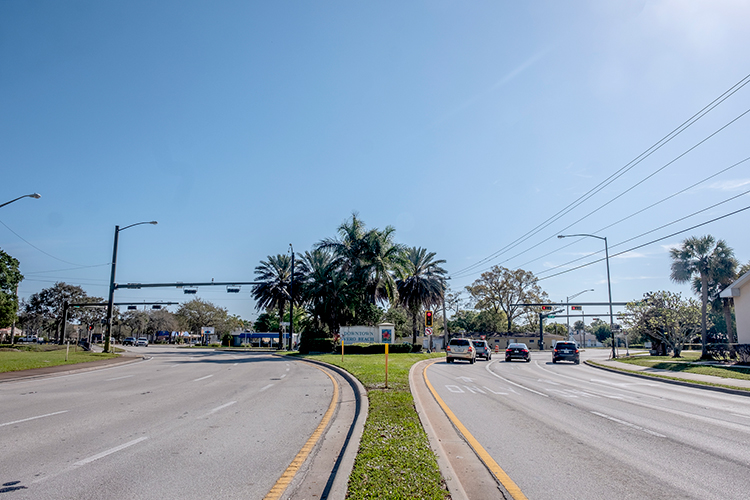
Let’s start with what was missing from the city-hired consultant’s detailed and comprehensive presentation of what could be done in Vero Beach’s downtown area if State Road 60 were reduced to two lanes in each direction:
Even a shred of meaningful evidence that the proposed lane reduction, being pushed hard by three of the City Council’s five members, would do anything to enhance the oft-discussed revitalization of downtown Vero.
The reason was obvious.
There isn’t any.
If anything, the public presentation given last week by Brian Good, whose local Kimley-Horn & Associates firm conducted the two-phase study, offered more reasons to reject the wrongheaded proposal than to embrace it.
Drastically reducing lanes along the most heavily trafficked busiest east-west corridor in a county experiencing a surge in population, particularly to the west of downtown?
Arguing that creating a bottleneck through the downtown area won’t result in lengthy traffic backups – especially during our busy season – and prompt frustrated drivers to find alternative routes through adjacent residential neighborhoods?
Inviting people to parallel park in 59 newly created spaces along State Road 60, where drivers attempting to park would block one of the two lanes of traffic and people exiting cars would open their doors into traffic?
What could go wrong there?
And what happens when that streetside parking, along with the inevitable jaywalking, produces accidents that require emergency services? Do we simply close the road entirely?
No one, then, should’ve been surprised by the audience’s overwhelming rejection of the lane-reduction proposal last Thursday night at the Vero Beach Community Center.
More than 30 residents in the audience addressed the City Council in the first of four scheduled public-workshop meetings on the matter. Only eight expressed support for it. All eight were downtown business owners or had some vested interest in the area.
We can expect a similar public response at the next three sessions – a county Metropolitan Planning Organization meeting scheduled for Oct. 25, followed by City Council hearings on Nov. 16 and Dec. 12.
The council will vote at that December meeting, but it makeup will have changed: While Mayor John Cotugno should be a lock to win re-election in November, Rey Neville is not seeking a third term, to be replaced by former council member Honey Minuse or third-time candidate Taylor Dingle.
Without Neville’s vote, Vice Mayor Linda Moore and Councilman John Carroll – both staunchly in favor of the lane reduction – are likely to be disappointed, knowing this is their last real chance to narrow the Twin Pairs.
But they shouldn’t be.
Not only are they backing a bad idea that is not in the best interests of the community at large, but reducing lanes along the State Road 60 would not make downtown the mecca that hey believe it can be.
Truth is, once the much-anticipated Three Corners project is open for business, the mainland waterfront will become the city’s park-like hub for the next 50 to 100 years.
And as former Vero Beach mayor Val Zudans pointed out at the workshop: With so much of the county’s future growth destined for the vast spaces west of the city, those residents will need all seven of the existing Twin Pairs lanes to get there and return home.
That doesn’t mean Downtown Vero can’t still be a desirable gathering place. The current City Council is determined to develop a master plan for the area’s revitalization.
Any significant downtown renaissance, however, would require mixed-use development to get more people living there. It also would need to offer a different vibe than the Three Corners and Ocean Drive. It doesn’t need draconian changes to the Twin Pairs.
Maybe you noticed: Robert Gibbs, one of the nation’s most highly regarded urban retail consultants, did not recommend the lane reduction in his 1,000-page report, commissioned by the City Council earlier this year in advance of its downtown master plan discussions.
That should be telling.
But only if you’re listening.
If the City Council members were listening last week, they should have heard enough to dump the shortsighted lane-reduction proposal and revive the more reasonable traffic-calming measures approved by their predecessors in 2021, after receiving the results of a study that showed the Twin Pairs were safe and speeding wasn’t a significant problem.
It was ridiculous, really, for the council to have discarded those more palatable measures – reduce the speed limit to 35, narrow driving lanes to require more caution, widen bike lanes and add crosswalks – and waste $165,000 of the city taxpayers’ money on another Kimley-Horn traffic study that produced statistics and projections that might or might not be reliable.
Speaking of spending money: The Florida Department of Transportation will cover the costs of repaving and re-striping State Road 60, a $6.7 million project scheduled to begin in fiscal 2026-27. But, according to Good, the city would still need to spend $1.9 million to cover the additional costs of reconfiguring the roadway and making other improvements.
We’d then be stuck with the reduced lanes for at least 25 years, regardless of how much the county’s population, which is already racing toward 170,000, continues to grow.
We can’t let that happen.



